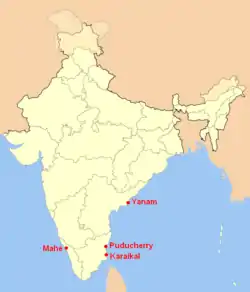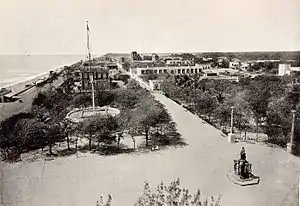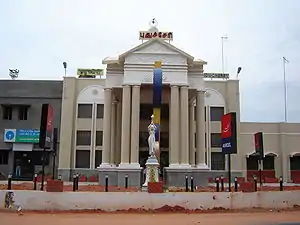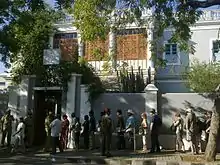Pondicherry
Pondicherry (/pɒndɪˈtʃɛri/), officially known as Puducherry (/pʊdʊˈtʃɛri/) (French: Pondichéry), is the capital and the most-populous city of the Union Territory of Puducherry in India. The city is in the Puducherry district on the southeast coast of India and is surrounded by the state of Tamil Nadu, with which it shares most of its culture and language.[3]
Pondicherry | |
|---|---|
| Puducherry | |
 Clockwise from top right: Gandhi statue, Promenade Beach, Matrimandir, Sri Aurobindo Ashram, Immaculate Conception Cathedral, Aayi Mandapam (monument), Basilica of the Sacred Heart of Jesus, Manakula Vinayagar Temple | |
| Nickname(s): | |
 Location of Puducherry in India along with the other districts of the Union Territory of Puducherry | |
 Pondicherry Location of Puducherry in India along with the other districts of the Union Territory of Puducherry  Pondicherry Pondicherry (India) | |
| Coordinates: 11°55′N 79°49′E | |
| Country | |
| Union territory | Puducherry (PY) |
| District | Pondicherry |
| Established | 1674 |
| Government | |
| • Type | Municipal Council |
| • Body | Pondicherry Municipal Council (PDY) |
| Area | |
| • Total | 19.54 km2 (7.54 sq mi) |
| Elevation | 3 m (10 ft) |
| Population (2011) | |
| • Total | 244,377 |
| • Density | 13,000/km2 (32,000/sq mi) |
| Demonym(s) | Puducherrian, Pondicherrian, Pondian |
| Time zone | UTC+5:30 (IST) |
| PIN CODE | 605001-605014 |
| Telephone code | (International) +91-413-, (National) 0413- |
| Vehicle registration | PY-01 to PY-05 |
| Website | https://www.py.gov.in/ |
Pondicherry Municipality consists of 42 wards. Wards 1–10 are north of the city. Wards 11–19 are in Boulevard Town and remaining wards are southwest of the city centre.[4]
History

The history of Pondicherry is recorded only after the arrival of Dutch, Portuguese, British and French traders. By contrast, nearby places such as Arikamedu, Ariyankuppam, Kakayanthoppe, Villianur and Bahour, which were colonised by the French East India Company over a period of time and later became the union territory of Pondicherry, have recorded histories that predate the colonial period.
Poduke or Poduca (a marketplace) was a Roman trading destination from the 3rd century BCE.[5] Poduca has been identified as possibly being Arikamedu (now part of Ariyankuppam), located about 2 miles (3.2 km) from the modern city of Pondicherry. The area was part of the Pallava Kingdom of Kanchipuram in the 4th century. The Cholas of Thanjavur held it from the 10th to 13th centuries until it was replaced by the Pandya Kingdom in the 13th century. The Vijayanagar Empire took control of almost all of the south of India in the 14th century and maintained control until 1638 when they were supplanted by the Sultan of Bijapur.
In 1674 the French East India Company set up a trading centre at Pondicherry and this outpost eventually became the chief French settlement in India. The French governor François Martin made remarkable improvements to the city and its commercial ties, facing at the same time strong opposition from the Dutch and the English. He entered into extended negotiations with the sultans of Golconda through the intercession of several roving French merchants and doctors who were in favour with the Sultan. Trading in jewelry and precious stones which had become highly fashionable in European courts was one among many activities. Five trading posts were established along the south Indian coast between 1668 and 1674. The city was separated by a canal into the French Quarter and the Indian Quarter.[6]
On 16 January 1761, the British captured Pondicherry from the French, but it was returned under the Treaty of Paris (1763) at the conclusion of the Seven Years' War.[7] In 1792, Venant of Durfort, son of the Count of Civrac, was made governor of Pondicherry, thanks to his uncle Emmanuel-Félicité, Duke of Duras, who had been made president of the Compagnie des Indes in 1788. After an outstanding military career in Europe, Venant fought hard to destroy all revolutionary hopes in Pondicherry, as republican ideals coming from France were threatening the economic stability of the region. He took great care to maintain commercial relations with other European powers in the region. His links with England were strengthened through his marriage with Catherine Browne of Kilmor. Venant died in July 1792 and was buried at Our Lady of Angels in Pondicherry.[8] The British took control of the area again in 1793 at the Siege of Pondicherry amid the Wars of the French Revolution, and returned it to France in 1814.
On 18 March 1954, a number of resolutions were passed by the municipalities in Pondicherry demanding immediate merger with India. Some days later, similar resolutions were passed by the municipalities in Karaikal. The resolutions had the full support of the French Indian Councillors, who are popularly known as Ministers, and the President of the Representative Assembly. These Municipalities represent roughly 90 percent of the population of the French possessions and they called upon the Government of France to take urgent and necessary measures to give effect to the wishes of the people.[9] The Government of India had made it clear that the cultural and other rights of the people would be fully respected. They were not asking for the immediate transfer of the de jure sovereignty of France. Their suggestion was that a de facto transfer of the administration should take place immediately, while French sovereignty should continue until the constitutional issue had been settled. Both India and France would have to make necessary changes in their respective Constitutions. All this would take time, while the demand of the people was for immediate merger without a referendum. The Government of India was convinced that the suggestion which they made would help to promote a settlement, which they greatly desired. They would gladly enter into negotiations with the Government of France on the basis suggested.[10]
On 18 October 1954 in a general election involving 178 people in Pondicherry Municipal and Commune Panchayat, 170 people were in favour of independence and eight people voted against. The de facto transfer of the French Indian territories from French governance to the Indian union took place on 1 November 1954 and was established as the union territory of Pondicherry. However, the formal de jure transfer of territory agreement between France and India was signed on 16 August 1962.
Topography
The topography of Pondicherry is the same as that of coastal Tamil Nadu. Pondicherry's average elevation is at sea level, and a number of sea inlets, referred to as "backwaters" can be found. Pondicherry experiences extreme coastal erosion as a result of a breakwater constructed in 1989,[11] just to the south of the city. Where there was once a broad, sandy beach, now the city is protected against the sea by a 2-km-long seawall which sits at a height of 8.5 m above sea level. Whilst there was an early seawall made by the French government in 1735, this was not "hard structure coastal defense" so much as an adjunct to the old shipping pier and a transition from the beach to the city,[12]
Today, the seawall consists of rows of granite boulders which are reinforced every year in an attempt to stop erosion. As a consequence of the seawall, there is severe seabed erosion and turbulence at the coastal margin, resulting in an extreme loss of biodiversity within the critical intertidal zone. Whenever gaps appear as the stones fall into the continually eroding seabed, the government adds more boulders. Pondicherry's seawall has also caused beach erosion to migrate further up the coast, to the fishing villages in Puducherry and Tamil Nadu to the north of the city.
Economy
In 2012, the Ministry of Power inaugurated the Smart Grid project in Puducherry.[13] Farming around Pondicherry include crops such as rice, pulses, sugarcane, coconuts, and cotton. In 2016, the Pondicherry State Government Employees Central Federation presented a status paper on the fiscal and social crisis in Puducherry to Union Home Minister Rajnath Singh. The report stated that a "combination of a staggering debt, stagnant tax revenues and rampant misappropriation of funds has throttled the economy of the Union Territory" and called for measures on a war footing to "deliver good governance and end corruption."[14]
Climate
The climate of Pondicherry is classified by the Köppen climate classification as tropical wet and dry (As),[15] similar to that of coastal Tamil Nadu. Summer lasts from April to early June, when maximum temperatures may reach 41 °C (106 °F). The average maximum temperature is 36 °C (97 °F). Minimum temperatures are in the order of 28–32 °C (82–90 °F). This is followed by a period of high humidity and occasional thundershowers from June till September.
The northeast monsoon sets in during the middle of October, and Pondicherry gets the bulk of its annual rainfall during the period from October to December. The annual average rainfall is 1,355 millimetres or 53 inches.[16] Winters are very warm, with highs of 30 °C (86 °F) and lows often dipping to around 18–20 °C (64–68 °F).
| Climate data for Pondicherry Airport | |||||||||||||
|---|---|---|---|---|---|---|---|---|---|---|---|---|---|
| Month | Jan | Feb | Mar | Apr | May | Jun | Jul | Aug | Sep | Oct | Nov | Dec | Year |
| Record high °C (°F) | 33.2 (91.8) |
35.2 (95.4) |
37.2 (99.0) |
41.8 (107.2) |
43.1 (109.6) |
41.7 (107.1) |
40.7 (105.3) |
40.2 (104.4) |
38.6 (101.5) |
37.9 (100.2) |
36.3 (97.3) |
32.5 (90.5) |
43.1 (109.6) |
| Average high °C (°F) | 29.0 (84.2) |
30.0 (86.0) |
31.2 (88.2) |
32.8 (91.0) |
34.6 (94.3) |
35.8 (96.4) |
34.5 (94.1) |
33.9 (93.0) |
33.1 (91.6) |
31.5 (88.7) |
29.8 (85.6) |
29.0 (84.2) |
32.1 (89.8) |
| Average low °C (°F) | 21.9 (71.4) |
22.5 (72.5) |
23.8 (74.8) |
25.9 (78.6) |
26.8 (80.2) |
26.5 (79.7) |
25.7 (78.3) |
25.2 (77.4) |
24.9 (76.8) |
24.5 (76.1) |
23.6 (74.5) |
22.6 (72.7) |
24.5 (76.1) |
| Record low °C (°F) | 17.1 (62.8) |
17.3 (63.1) |
18.8 (65.8) |
21.9 (71.4) |
21.9 (71.4) |
21.5 (70.7) |
21.6 (70.9) |
21.4 (70.5) |
21.5 (70.7) |
19.6 (67.3) |
16.5 (61.7) |
17.1 (62.8) |
16.5 (61.7) |
| Average rainfall mm (inches) | 12.3 (0.48) |
22.2 (0.87) |
19.3 (0.76) |
7.8 (0.31) |
48.6 (1.91) |
48.0 (1.89) |
89.5 (3.52) |
132.3 (5.21) |
132.8 (5.23) |
273.9 (10.78) |
350.0 (13.78) |
217.3 (8.56) |
1,354 (53.3) |
| Average rainy days | 0.9 | 0.9 | 0.8 | 0.4 | 1.9 | 2.8 | 5.3 | 6.7 | 6.5 | 10.3 | 11.8 | 6.8 | 55.0 |
| Source: India Meteorological Department (record high and low up to 2010)[17][18] | |||||||||||||
Demographics


According to the 2011 census of India, Pondicherry had a population of 244,377, with 124,947 females and 119,430 males. Pondicherry had an average literacy rate of 80.6% with male literacy at 84.6% and female literacy at 76.7%. In Pondicherry, 10% of the population was under six years of age.[2]
The majority speak Tamil in Pondicherry. There is a community of French people and a number of French institutions such as the consulate of France in Pondicherry, the French Institute of Pondicherry and L'Alliance française.[19]
Civic administration
The Union Territory of Puducherry comprises two districts, Puducherry and Karaikal. Puducherry district comprises Puducherry region and two outlying administrative units of Mahe and Yanam. All four districts bear a strong resemblance to the colonial French rule of the ancient times.[20] All the Municipalities and the Commune Panchayats in the Union Territory of Puducherry function under the Administrative control of the Local Administration Department.[21] The Puducherry Municipality under the Puducherry District comprises the erstwhile Communes of Puducherry and Mudaliarpet with its headquarters is in Puduicherry. It has a total of 42 wards spread over an areas of 19.46 Sq. km.[22]
Urban agglomeration

| Local bodies | Area | Population |
|---|---|---|
| Pondicherry Municipality | 19 km2 | 241,773 |
| Oulgaret Municipality | 36 km2 | 300,028 |
| Villianur Census Town and Outgrowth | 67,254 | |
| Ariyankuppam Town and Outgrowth | 47,454 | |
| Total | 293 km2 | 629,509 |
Data according to 2011 census
There are two proposals by the Puducherry government, firstly to merge Pondicherry and Oulgaret municipalities, and upgrade the Pondicherry municipality into a '"municipal corporation", and secondly to upgrade Villianur and Ariyankuppam commune panchayats into municipalities, which would increase the Pondicherry region's urban area around 155 km2. of the total 292 km2.
Transport

Road
Pondicherry is connected to Chennai via the East Coast Road through Mahabalipuram.[23] There are daily bus services from several main stops from Chennai. The Pondicherry Road Transport Corporation runs buses within the city and it runs Volvo buses to Chennai and to various places.[24] The Tamil Nadu State Transport Corporation operates Volvo air-conditioned bus services from Chennai to Pondicherry.[25]
Rail
PDY/Puducherry (Pondicherry) is connected by train to Chennai, Delhi, Kolkata, and Mumbai, as well as other important cities such as Kanyakumari, Hyderabad, Nagpur, Bhubaneshwar, Bangalore, Visakhapatnam and Mangalore.[26][27] Moreover, VM/Villupuram Junction which is at a distance of around 24 miles i.e.40 km(both by rail & road) is connected to several other Indian Cities.[28]
Tourism



Pondicherry is a tourist destination in South India. The city has many colonial buildings, churches, temples and statues which, combined with the town planning and French style avenues in the old part of town, still preserve much of the colonial ambiance.
While the sea is a draw for tourists, Pondicherry no longer has the sandy beaches that once graced its coastline. The breakwater to the harbour and other hard structures constructed on the shore caused extreme coastal erosion and the sand from Pondicherry's Promenade Beach was permitted to disappear entirely. As a result of the city's seawall and groyne construction, the beaches further up the coast to the north have also been lost. An enormous deposition of sand has accrued to the south of the harbour breakwater, but this is not a commodious beach and is not easily accessible from the city.
But recently, the government has been taking steps by constructing a reef and re-dosing sand. The sea is accessible by a small patch of land at the Promenade Beach (Goubert Avenue).[30] Moreover, the beach is one of the cleanest in India and has been selected for Blue Flag certification.[31]

The Sri Aurobindo Ashram, located on rue de la Marine, is one of the most important ashrams in India, founded by the renowned Freedom Fighter and spiritual philosopher Sri Aurobindo.[32] Auroville (City of Dawn) is an "experimental" township located 8 km north-west of Pondicherry.
There are a number of old and large churches in Pondicherry, most of which were built in the 18th and 19th centuries. A number of heritage buildings and monuments are present around the Promenade Beach, such as the Children's Park and Dupleix Statue, Gandhi statue, Nehru Statue, Le Café, French War Memorial, 19th Century Light House, Bharathi Park, Governors Palace, Romain Rolland Library, Legislative Assembly, Pondicherry Museum and the French Institute of Pondicherry at Saint Louis Street.
Puducherry Botanical Gardens is located south of the New Bus Stand. Chunnambar Backwater resort is situated 8 km from Pondicherry, along the Cuddalore Main Road. This tropical resort is flanked by a creek on one side.
Arulmigu Manakula Vinayagar Devasthanam on Manakula Vinayagar Street is a Hindu temple, which houses Lord Ganesha. Sri Manakula Vinayagar Temple was in existence before the French came and settled in Pondicherry i.e. before 1666.[33]
Sengazhuneer Amman Temple at Veerampattinam village is one of the oldest temples in Pondicherry, which is about 7 km away from the city centre. The car festival conducted in mid-August is famous in Puducherry and other neighboring states. The festival takes place on the fifth Friday since the commencement of the Tamil month of 'Aadi' every year from the date immemorial. The temple car festival is the only one where the head of the state pulls the temple car right from the days of the French rule.
Thirukaameeswarar Temple is one of the ancient temples located in a rural town called Villianur (the ancient name is Vilvanallur, from "vilva marangal niraindha nalla vur"),[34] which roughly translates as nice with archery trees is located about 10 km away (towards Villupuram) from Pondicherry. This temple is renowned as Periya Koil "Big Temple". The prime god is Lord Shiva and the prime goddess is Goddess Kokilambigai. There are other Hindu gods such as Murugan, Vinayagar, Thakshanamoorthy, Perumal, Bhramah, Chandikeshwarar, Natarajar, Navagrahah, and 63 Naayanmaars. The pioneers in this temple say that the age of this temple is about 1000 plus years. It is thought to have been built by one of the Chola kings. There is also a huge temple pond. The Ther Thiruvizha (chariot procession) is celebrated at this temple.
Social organisations
- Alliance Francaise de Pondicherry created in 1889 and is among the first Alliances in the world after the one in Paris.
- PondyCAN - is a broad based, non-profit organization committed to preserve and enhance the natural, social, cultural and spiritual environment.
Notable people
Leaders
- V. Subbiah, Trade Union leader & freedom fighter.
Literature and Arts
- Tamil poet Bharathiyar.
- Tamil poet Bharathidasan.
- Anandaraj, Tamil film actor
- Kalki Koechlin, Hindi movie actress
- Ayesha Kapur, Hindi movie actress
- M. Night Shyamalan, Hollywood director
- Tao Porchon-Lynch, Yoga instructor, American actress
Science and technology
- S. Somasegar, former senior vice-president, Microsoft
- Ganapathi Thanikaimoni, Indian scientist and director of the Palynology laboratory of the French Institute of Pondicherry
- Yvonne Artaud, French educationalist and psychologist.
- Navi Radjou, an innovation and leadership strategist based in Silicon Valley.[35]
Armed forces
- Maréchal Le Marquis de Lauriston (1768–1828), a very senior-ranking military commander in the French Army, was born in Pondicherry.
Fictional
- Prince Pondicherry, a character from Roald Dahl's Charlie and the Chocolate Factory, is named after the city. The character asked that Willy Wonka build him a palace made of chocolate. Given the heat of the Indian climate, this decision worked out poorly for the fictitious prince
- Pondicherry is the setting for the first third of Yann Martel's Booker Prize-winning novel Life of Pi (2001). A portion of the subsequent film adaptation was filmed there.[36]
- Lee Langley's novel A House in Pondicherry (1996).[37]
Educational institutions
Gallery
 Gate leading into Manakula Vinayagar Temple in White Town Pondicherry.
Gate leading into Manakula Vinayagar Temple in White Town Pondicherry. Tanjore Painting of Manakula Vinayagar in Pondicherry
Tanjore Painting of Manakula Vinayagar in Pondicherry Devotees with Elephant Lakshmi in Manakula Vinayagar Temple in Pondicherry
Devotees with Elephant Lakshmi in Manakula Vinayagar Temple in Pondicherry Beach by the Bay of Bengal, Pondicherry
Beach by the Bay of Bengal, Pondicherry Early morning walk by the bay of Bengal in Pondicherry
Early morning walk by the bay of Bengal in Pondicherry
See also
- Karaikal, India
- Mahé, India
- Manakula Vinayagar Temple
- Pondicherry urban area
- Yanam, India
References
- "The Paris of the East". Archived from the original on 16 December 2012.
- "District Census Handbook: Puducherry" (PDF). Census of India. Office of the Registrar General & Census Commissioner, India. pp. 86–87. Retrieved 11 February 2019.
- "Bill to rename Pondicherry as Puducherry passed". The Hindu. 22 August 2006. Retrieved 2 May 2016.
- Town and Country Planning Department, Pondicherry, India: City Development Plan – Pondicherry, Final Report, March 2007, S. 159 Archived 19 June 2009 at the Wayback Machine
- Francis, Peter (2002). Asia's Maritime Bead Trade: 300 B.C. to the Present. University of Hawaii Press. ISBN 978-0-8248-2332-0.
- WORRALL, JILL (11 April 2016). "Peace, love and a French flavour in Pondicherry, South India". www.stuff.co.nz. Retrieved 2 May 2016.
- Chand, Hukam. History Of Medieval India, 202.
- Durand, Yves (1975). La Maison de Durfort à l'Epoque Moderne. p. 261.
- https://eparlib.nic.in/bitstream/123456789/55921/1/lsd_01_06_06-04-1954.pdf page 22
- https://eparlib.nic.in/bitstream/123456789/55921/1/lsd_01_06_06-04-1954.pdf page 23
- "The Story of Pondicherry's Eroding Coastline in a Single Image". 16 October 2008.
- "Archived copy". Archived from the original on 16 September 2009. Retrieved 22 June 2009.CS1 maint: archived copy as title (link)
- "Smart grid project inaugurated". Puducherry. The Hindu. 20 October 2012. Retrieved 23 October 2012.
- Special Correspondent (18 October 2016). "Report paints grim picture of Puducherry's economy". The Hindu. Retrieved 28 October 2017.
- "Climate: Pondicherry – Climate graph, Temperature graph, Climate table". Climate-Data.org. Retrieved 6 October 2013.
- "Archived copy". Archived from the original on 26 July 2009. Retrieved 10 July 2009.CS1 maint: archived copy as title (link)
- "Pondicherry Climatological Table Period: 1971–2000". India Meteorological Department. Retrieved 11 April 2015.
- "Ever recorded Maximum and minimum temperatures up to 2010" (PDF). India Meteorological Department. Archived from the original (PDF) on 21 May 2013. Retrieved 11 April 2015.
- "Pondicherry: Forever France? by Anand Jha". 21 July 2012. Archived from the original on 21 July 2012. Retrieved 3 October 2013.
- "Districts - Know Puducherry: Government of Puducherry". www.py.gov.in. Retrieved 9 April 2020.
- "Local Administration-Departments-Know Puducherry: Government of Puducherry". www.py.gov.in. Retrieved 9 April 2020.
- "Municipality Details - Pondicherry Municipality - The Union Territory of Puducherry". www.pdymun.in. Retrieved 9 April 2020.
- Ramakrishnan, Deepa (23 February 2012). "After a decade on fast lane, ECR is set to expand". The Hindu. Chennai. Retrieved 16 September 2012.
- "20 buses launched in urban routes". The Hindu. Puducherry. 8 June 2010. Retrieved 19 September 2012.
- V, Venkatasubramanian (19 February 2010). "A boon to Kancheepuram unit of TNSTC". The Hindu. Kancheepuram. Retrieved 15 September 2012.
- "Delhi-Puducherry train link from July 3". The Hindu. 25 June 2011. Retrieved 16 September 2012.
- "Changes in train timings". The Hindu. Puducherry. 13 September 2012. Retrieved 16 September 2012.
- Ltd, rome2rio Pty. "Puducherry to Villupuram - 3 ways to travel via bus, and line 16116 train". Rome2rio. Retrieved 28 January 2020.
- "Puducherry back on aviation map; services to Hyderabad launched". The Economic Times. 16 August 2017. Retrieved 12 February 2019.
- M, Kavya (30 August 2018). "Artificial reef helps restore lost Pondy beach". Deccan Chronicle. Retrieved 28 January 2020.
- Jun 6, Bosco Dominique | TNN |; 2019; Ist, 12:31. "Beach in Puducherry selected for blue flag certification | Puducherry News - Times of India". The Times of India. Retrieved 28 January 2020.CS1 maint: numeric names: authors list (link)
- "Sri Aurobindo". Retrieved 19 July 2019.
- "Arulmigu Manakula Vinayagar Temple". Retrieved 19 July 2019.
- "About Pondicherry". India tourism. Retrieved 19 July 2019.
- "Archived copy". Archived from the original on 19 January 2015. Retrieved 19 January 2015.CS1 maint: archived copy as title (link)
- "Life of Pi". The Guardian. Retrieved 19 July 2019.
- "Of Love Lost". India Today. Retrieved 19 July 2019.

